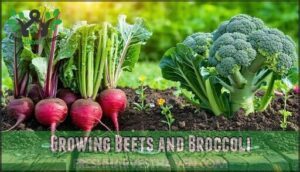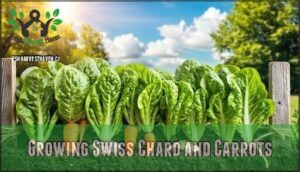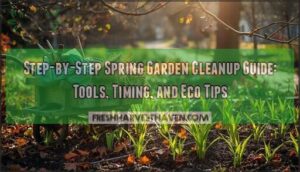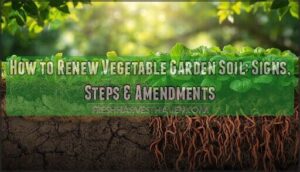This site is supported by our readers. We may earn a commission, at no cost to you, if you purchase through links.
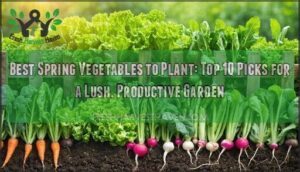
Plant lettuce, spinach, and kale for reliable leafy greens that won’t bolt in cooler weather. Radishes and carrots grow quickly in loose soil, while peas and beans fix nitrogen naturally.
Don’t overlook hardy options like broccoli, cabbage, and Swiss chard—they’ll handle light frosts like champs. Root vegetables such as beets and turnips store well through summer.
The secret isn’t just knowing what to plant, but understanding the timing tricks that separate novice gardeners from those who harvest continuously all season long, which is the key to continuous harvest.
Table Of Contents
- Key Takeaways
- Spring Vegetable Basics
- Top 10 Spring Vegetables
- 1. Bonnie Plants Hydroponic Lettuce Mix
- 2. Bok Choy Plants Ready to Plant
- 3. Mix Red Yellow White Onion Sets
- 4. Organic Green Onion Seeds
- 5. Seeds of Change Red Cherry Radish
- 6. Live Asparagus Bare Root Plants
- 7. Live Artichoke Plant Vegetable
- 8. Green Bell Pepper Plants
- 9. Bonnie Plants Big Boy Tomato Plants
- 10. Chard Plants Ready to Plant
- Cool Season Crops
- Easy Spring Options
- Fast Growing Spring Choices
- Frequently Asked Questions (FAQs)
- What are the fastest growing spring vegetables?
- What are the best beginner vegetables to grow?
- What is the best order to plant vegetables in a garden?
- What vegetables are good in spring?
- What is the easiest plant to grow in spring?
- What vegetables can and cannot be planted next to each other?
- When should I start planting my garden in the spring?
- In what order should I plant my vegetable garden?
- What are the best vegetables to grow in April?
- When should a spring garden be planted?
- Conclusion
Key Takeaways
- Start with cool-season crops early – You’ll get the best results by planting lettuce, spinach, kale, and radishes 4-6 weeks before your last frost date, since they thrive in mild temperatures and handle light frosts.
- Choose fast-growing varieties for quick wins – You can harvest radishes in just 3-4 weeks, arugula in 10-14 days, and baby greens within a month, giving you fresh produce while building gardening confidence.
- Plant succession crops every 2-3 weeks – You’ll enjoy continuous harvests throughout spring by staggering plantings of green onions, lettuce, and other quick-maturing vegetables, rather than planting everything at once.
- Focus on reliable beginner-friendly options – You’ll have the most success with foolproof vegetables like lettuce, spinach, and radishes that grow with minimal care and forgive common mistakes while you learn proper techniques.
Spring Vegetable Basics
You’ll get the best results in spring by choosing vegetables suited to cool soil and changing weather.
Understanding which crops thrive early helps you plan for a healthy, productive garden.
Leafy Greens and Their Characteristics
Most gardeners discover that leafy greens offer the fastest path to spring success.
Leafy greens unlock spring’s quickest gardening victories with minimal effort required.
These nutrient-dense greens thrive in cool season crops conditions, delivering harvests within weeks of planting.
Here are five essential spring vegetable gardening leafy greens to keep in mind:
- Spinach – Packed with iron and vitamins, spinach nutrition peaks when harvested young before leaves turn bitter
- Lettuce – Multiple lettuce types from butterhead to romaine provide crisp textures for fresh salads
- Kale – Cold-hardy with improved flavor after frost, kale harvest continues through cooler months
- Arugula – Peppery arugula benefits include rapid growth and distinctive flavor for gourmet dishes
- Swiss chard – Colorful stems and mild taste make this reliable coolweather legume perfect for beginners
Root Vegetables and Their Cultivation
While leafy greens shine above ground, root vegetables work magic below.
These cool season crops need loose, well-drained soil for proper development.
Carrot Care requires consistent moisture, while Radish Growth happens fast in spring conditions.
Beet Farming tolerates various soil types, and Turnip Harvest provides both roots and greens.
| Vegetable | Days to Harvest | Soil Temperature |
|---|---|---|
| Radishes | 30-40 days | 40-50°F |
| Carrots | 70-80 days | 50-60°F |
| Beets | 50-70 days | 45-65°F |
| Turnips | 45-60 days | 40-75°F |
Parsnip Planting requires patience—they’re slow growers.
Your spring vegetable gardening success depends on proper spring vegetable seeds spacing and timing.
Perennial Vegetables and Unique Crops
Perennial vegetables offer a smart investment for your spring garden’s future. Asparagus Care requires patience—these crowns need 2-3 years before harvest, but they’ll produce tender spears for decades. Fiddlehead Ferns emerge as tightly coiled European wild greens, offering unique tastes and textures when properly harvested in early spring.
Cardoon Harvest presents challenges with its spiny stalks, while Artichoke Growth transforms gardens into Mediterranean landscapes. Nettle Benefits include powerful antioxidants, though handling requires gloves. These coolseason crops establish permanent garden real estate.
Here’s what makes perennial vegetables special:
- Freedom from replanting – Set once, harvest for years
- Safety in investment – Reliable yields despite weather changes
- Mastery through patience – Deeper gardening satisfaction
- Unique flavors – Tastes you can’t buy in stores
These hardy plants reward your initial effort with years of distinctive harvests.
Top 10 Spring Vegetables
You’ll discover these ten spring vegetables deliver impressive yields while adapting perfectly to cool-season growing conditions.
Each variety offers unique advantages that make spring planting both rewarding and productive for your garden.
1. Bonnie Plants Hydroponic Lettuce Mix
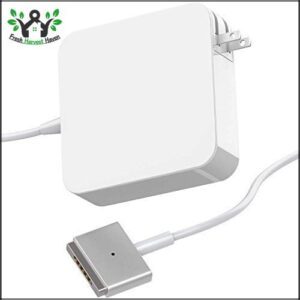
You can enjoy crisp, homegrown salads faster with Bonnie Plants Hydroponic Lettuce Mix. This convenient kit delivers two Amanda Green Leaf and two Red Leaf seedlings in sturdy peat plugs that won’t dissolve in hydroponic systems.
The pre-grown transplants shave weeks off your spring harvest timeline compared to seed starting.
For lettuce care, space plants 12 inches apart in well-draining soil. Water daily during establishment, especially in warm weather.
These leafy greens thrive in cool spring vegetable gardening conditions, making them perfect easy spring vegetables for beginners.
The compact plugs (1.4" × 1.4" × 1.8") move seamlessly from hydroponic setups to traditional garden beds. This system works great for spring garden plants enthusiasts who want reliable results without fuss.
Best For: Indoor growers seeking fresh greens year-round through efficient planting spring vegetables methods.
2. Bok Choy Plants Ready to Plant
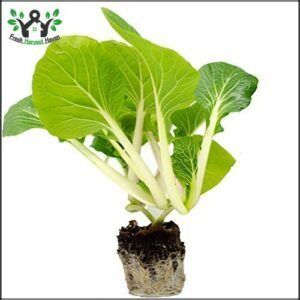
Bok choy plants deliver exceptional results for spring vegetable gardening enthusiasts.
These cool weather crops mature in just 35-45 days, making them perfect for impatient gardeners who want quick harvests.
Your bok choy care routine couldn’t be simpler.
Plant these Asian greens with 6-inch spacing in well-draining soil.
They’ll thrive in containers or garden beds with consistent moisture and 6-8 hours of daily sunlight.
Each plant produces 1-2 pounds of vitamin-packed leaves rich in A, C, and K.
For extended yields, harvest outer leaves first while inner growth continues.
Miniature varieties handle temperature swings better than full-size types, giving you flexibility in your garden planning.
These easy spring vegetables tolerate light frosts and grow steadily in cool season conditions.
Your planting tips should include succession sowing every 2-3 weeks for continuous harvests throughout spring.
Best For: Gardeners wanting nutrient-dense greens with minimal fuss and maximum flavor in small spaces.
3. Mix Red Yellow White Onion Sets
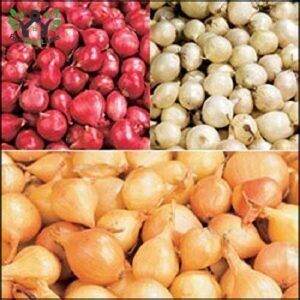
While onion sets might seem like small potatoes, they’re actually your ticket to a colorful harvest. This Mix Red Yellow White Onion Sets collection gives you three distinct onion varieties in one convenient package. Set planting requires simple soil preparation – just loose, well-drained earth and full sun exposure.
Plant these onion sets 3-6 inches apart in early spring when soil temperatures reach 50°F. The color mixing strategy pays off big time: red onions add punch to salads, yellow onions handle cooking heat like champs, and white onions shine in fresh applications.
Harvest timing occurs 90-120 days after planting when green tops naturally fall over. Each set develops into full-sized bulbs packed with antioxidants and nutrients. Unlike spring onions, scallions, shallots, or leek onions, these storage onions cure well for long-term use. Rotate planting locations yearly for ideal soil health and disease prevention.
4. Organic Green Onion Seeds
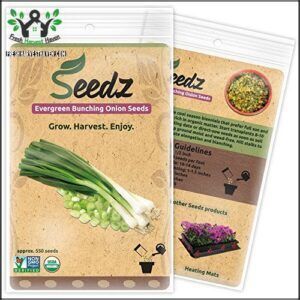
When selecting organic green onion seeds for your spring vegetable gardening project, SEEDZ offers excellent Seed Selection with 550 seeds per pack.
These USDA Certified Organic, non-GMO heirloom varieties guarantee high germination rates for successful Organic Methods.
Perfect for Spring Sowing, they’ll produce tall scallions with crisp, silvery-white stalks in 56-60 days.
Your Green Harvest thrives in full sun with consistent moisture and 6.0-7.0 pH soil.
Onion Care stays simple since they’re naturally resistant to Pink Root and Smut diseases.
You’ll enjoy continuous harvesting from April through November, making these spring onion seeds ideal for home gardeners wanting reliable, disease-resistant green onions that’ll keep your kitchen stocked with fresh flavor all season long.
5. Seeds of Change Red Cherry Radish
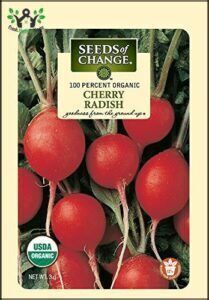
Why settle for ordinary radishes when you can grow these vibrant red beauties in just 25 days? Seeds of Change Red Cherry Radish delivers exceptional results for spring vegetable gardening enthusiasts.
These organic, non-GMO seeds germinate quickly in cool spring conditions, making them perfect cool-tolerant veggies for your garden.
You’ll harvest crisp, mildly peppery radishes that add color and crunch to salads and sandwiches. Radish care couldn’t be simpler – they tolerate poor soil and dry conditions.
Seed starting requires minimal effort since nearly every seed produces a healthy plant. Plant in full sun for best results.
The edible greens provide bonus nutrition for radish recipes. Kids love watching these fast-growing vegetables develop, making them ideal for family garden tips projects.
Best For: Beginner gardeners, families, and anyone wanting quick results from their spring planting efforts in their vegetable planting guide.
6. Live Asparagus Bare Root Plants
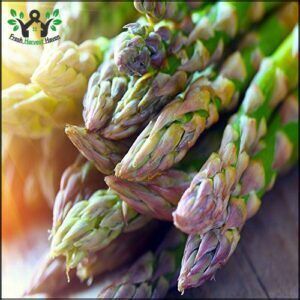
Live asparagus bare root plants represent the ultimate investment in your spring vegetable gardening journey. These perennial powerhouses deliver harvests for decades once established.
Plant crowns 6-8 inches deep in well-drained soil with neutral pH, spacing them 12-18 inches apart for ideal root development. You’ll need patience—harvest timing requires waiting 2-3 years for full spear production, but this waiting period guarantees strong root systems.
Popular varieties like Jersey Knight and Purple Passion thrive with minimal asparagus care once established.
- Soil preparation: Amend with compost and guarantee excellent drainage for healthy root development
- Planting tips: Water consistently during establishment, applying 1-2 inches weekly
- Long-term rewards: Harvest 6-10 inch spears annually for up to 20 years
Best for: Patient gardeners seeking low-maintenance, high-yield perennial crops in their vegetable gardening 101 repertoire.
7. Live Artichoke Plant Vegetable
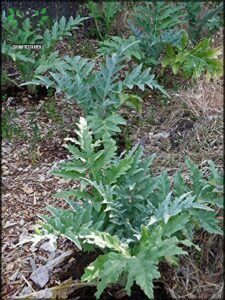
Artichoke plants transform your spring garden into both an ornamental showcase and productive harvest zone.
These perennial plants thrive as cool-weather crops in zones 7-11, producing 8-10 edible flower buds annually.
Spring planting requires full sun, well-drained soil with pH 6.0-6.8, and consistent watering.
Harvest firm, tight buds for ideal artichoke recipes.
Cold-climate gardeners can grow them in containers for winter protection.
With proper artichoke care, these architectural beauties provide years of gourmet harvests while adding stunning visual appeal to your vegetable gardening space.
8. Green Bell Pepper Plants
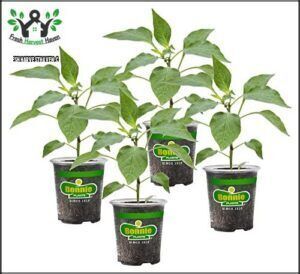
Green bell peppers rank among the most reliable spring vegetables for your garden. These pepper varieties deliver consistent results with proper pepper care. Plant seedlings 18-24 inches apart in full sun, providing stakes as they mature.
Unlike many cool-weather crops, bell peppers handle both light frost and summer heat remarkably well. Start seed starting indoors 8-10 weeks before your last frost date for early spring planting.
They’re perfect vegetable gardening companions to green onions since both thrive in similar conditions. Container growing works excellently, especially in zones 7 and warmer.
Your green harvest arrives in 75+ days, producing sweet, thick-walled peppers perfect for fresh eating, cooking, or freezing. The bell pepper plants continue producing until hard frost, making them exceptional value crops for dedicated gardeners seeking long-season productivity.
Successful gardeners often utilize companion planting techniques to maximize yields and reduce pests.
9. Bonnie Plants Big Boy Tomato Plants
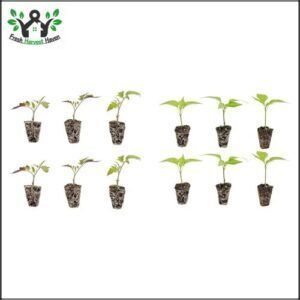
Bonnie Plants Big Boy Tomato Plants deliver restaurant-quality beefsteak tomatoes that’ll transform your spring vegetables garden into a productive powerhouse. These indeterminate tomato plants produce massive fruits weighing up to 32 ounces, perfect for thick sandwich slices and fresh salads.
You’ll get continuous harvests from mid-season through frost, with plants maturing in 78 days after early spring planting. Their crack-resistant skin handles temperature fluctuations better than most varieties.
Essential growing tips for Big Boy success:
- Soil Quality: Plant in well-draining, nutrient-rich soil with pH 6.0-6.8
- Tomato Care: Provide sturdy cages or stakes for heavy fruit support
- Fertilizer Tips: Apply balanced fertilizer every 2-3 weeks during growing season
- Plant Diseases: Guarantee good air circulation to prevent fungal issues
- Garden Tools: Use clean pruning shears for maintenance and harvesting
These cool-weather crops shift beautifully into warm-season production, making them ideal for vegetable gardening beginners and experts alike.
Best For: Gardeners wanting large, flavorful tomatoes with reliable harvests.
10. Chard Plants Ready to Plant
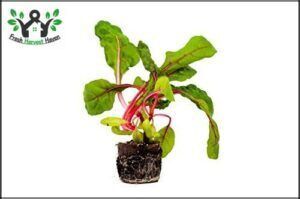
You’ll appreciate how ready-to-plant chard delivers instant garden satisfaction with minimal fuss. These vibrant spring vegetables showcase stunning varieties like rainbow, red, and Swiss chard, each displaying glossy green leaves with colorful stems that’ll make your neighbors jealous.
Ready-to-plant chard opens the door to garden success with vibrant leaves and minimal effort required.
Soil preparation starts with well-draining earth at pH 6.0-7.0. Water daily after transplanting until plants develop 10-15 leaves. These cool-weather crops handle spring temperatures perfectly but tolerate summer heat with proper chard care.
Gardening tips for success: harvest young, tender leafy greens for salads, soups, and stir-fries. You’ll yield up to a pound of nutritious greens per plant. Plant nutrition stays high throughout the growing season, making chard a reliable vegetable gardening choice.
Best For: Any gardener wanting easy-to-grow, nutritious, visually appealing greens for spring vegetable planting.
Cool Season Crops
Cool season crops thrive in spring’s mild temperatures and can handle light frosts that would damage warm-season plants.
You’ll get the best results by planting these hardy vegetables 4-6 weeks before your last expected frost date.
Planting Artichokes and Asparagus
Now you’ll explore two powerhouse perennial plants that’ll reward your patience with decades of harvests. Artichokes and asparagus demand thoughtful garden planning but deliver exceptional returns through proper artichoke care and asparagus harvest techniques.
These cool-weather crops thrive with early spring planting when you follow these guidelines:
- Plant artichoke transplants 18 inches apart in fertile, well-drained soil
- Space asparagus crowns 9-12 inches apart in 6-inch deep trenches
- Apply spring fertilizers high in nitrogen every 4 weeks for artichokes
- Provide 1-2 inches weekly water via drip irrigation systems
- Harvest artichoke buds before bracts open, asparagus spears at 6-8 inches tall
Both crops require full sun and pH 6.5-7.0 soil for ideal spring vegetable planting success. For successful growth, understanding soil preparation methods is vital for artichoke cultivation.
Growing Beets and Broccoli
Beets and broccoli excel in spring planting conditions.
Plant beets in loose soil around 50°F for ideal beet nutrition – both roots and greens pack vitamins.
Broccoli needs 18-inch spacing and consistent moisture for proper broccoli care.
These best spring veggies mature quickly, giving you fresh vegetable harvest within weeks.
Practice crop rotation to maintain soil health when growing spring vegetables in your spring vegetable gardening setup.
Benefits of Planting Kale and Peppers
Kale and peppers consistently deliver exceptional spring vegetable benefits for your garden planning strategy.
Kale nutrition shines with vitamins A, C, E, and K, while diverse pepper varieties like hot banana and shishito thrive in seasonal weather.
Plant kale 4-6 weeks before frost for ideal spring harvest timing. These cool-weather crops complement your crop rotation system perfectly.
Spring vegetable nutrition peaks when you companion plant kale with basil and peppers with spinach, naturally repelling pests while maximizing flavor development.
Effective companion planting strategies can substantially enhance the health and productivity of your kale plants.
Easy Spring Options
When you want reliable results without the fuss, these beginner-friendly vegetables practically grow themselves with minimal garden experience required.
You’ll get fresh harvests in just weeks while building confidence for more challenging crops later in the season, which is a great way to start with reliable results.
Planting Peas and Radishes
Peas and radishes make perfect spring partners for your garden. Seed Selection matters – choose Pea Varieties like Sugar Snap or Snow Peas for best results.
Plant pea seeds 1-inch deep while radishes need 2-3 inches spacing. These cool-weather crops love spring vegetable planting conditions and actually improve each other’s growth.
Soil Preparation should include loose, well-draining earth. Smart Garden Layout puts them together since radishes mature in 30-40 days while peas need about 60 days.
Radish Care involves regular watering, and both crops handle light frosts well. This spring vegetable care approach gives you quick harvests from your plot.
For superior growth, understanding pea seed types is essential to make informed decisions about your garden.
Growing Swiss Chard and Carrots
Swiss chard and carrots are natural partners for your Garden Planning success. These cool weather crops handle spring’s unpredictable moods like champs.
Here’s your Soil Preparation game plan:
- Loosen soil 6-8 inches deep for proper Root Health
- Choose shorter Carrot Varieties for heavy clay soils
- Space Swiss chard plants 6 inches apart for ideal growth
Swiss Chard Care couldn’t be simpler – it’s practically bulletproof once established. Your spring vegetable gardening efforts pay off when both crops thrive in cooler temperatures, giving you fresh harvests while others wait for warmer weather.
Successive Sowing of Green Onions
Stagger your green onion plantings every 2 weeks for continuous harvest throughout spring.
Start successive sowing when soil hits 45°F, maintaining proper seed selection and soil preparation. Each batch matures in 4-8 weeks with ideal harvest timing.
This green sowing method guarantees fresh cool-weather crops all season. Follow smart onion care and vegetable gardening tips for best results.
Understanding succession planting techniques is vital for maximizing yields and maintaining a steady supply of fresh produce.
Fast Growing Spring Choices
When you need fresh vegetables on your table quickly, fast-growing spring crops deliver results in just weeks rather than months.
These rapid producers like radishes and baby greens can go from seed to harvest in as little as 30 days, giving you instant satisfaction and continuous fresh produce throughout the growing season.
Planting Beets and Turnips
Anyone can master Beet Cultivation and Turnip Care with proper timing.
These cool weather crops germinate in 40°F soil, making them perfect for spring vegetable planting. Focus on Soil Preparation by loosening earth 8-12 inches deep for maximum Root Health.
Beets offer colorful varieties while turnips provide dual harvests. Both crops reach Harvest Timing in 30-50 days.
These vegetable gardening tips guarantee quick, reliable yields for impatient gardeners. Understanding companion planting is vital for maximizing garden space and reducing pests.
Growing Potatoes and Broccoli
Potatoes and broccoli make excellent additions to your fast-growing spring lineup.
These cool-weather crops thrive when you plant them early, giving you fresh harvests before summer heat arrives.
Proper soil preparation and fertilizer tips guarantee healthy growth for both spring vegetable varieties.
- Potato Care: Plant certified seed potatoes 4-6 inches deep in well-draining soil with pH 5.8-6.5
- Broccoli Pests: Space plants 18 inches apart and use companion herbs to deter cabbage worms naturally
- Crop Rotation: Follow your vegetable planting calendar to avoid soil-borne diseases and maintain nutrients
Check your frost date before planting these crops outdoors.
Benefits of Early Spring Planting for Nutrient Rich Harvests
Early spring planting transforms your garden into a nutrient powerhouse. Cool-weather crops develop deeper root systems, accessing more minerals before summer heat arrives. Your vegetables concentrate higher vitamin levels during slower spring growth.
Spring planting unlocks nature’s nutrient factory before summer stress kicks in.
Pest pressure drops substantially when crops mature before insect populations peak. To achieve maximum growth, selecting the right Spring Vegetable is essential for a lush garden.
| Early Spring Benefits | Late Planting Results |
|---|---|
| Nutrient-dense flavors from cool maturation | Bitter, stressed vegetables from heat |
| Extended harvest timing through succession | Single harvest window |
| Natural pest resistance from early maturity | Higher pest damage rates |
| Improved soil preparation through root cycling | Shallow root development |
Smart seed selection and proper crop rotation maximize these advantages for spring vegetable varieties.
Frequently Asked Questions (FAQs)
What are the fastest growing spring vegetables?
Radishes lead the pack, ready in just 3-4 weeks. Cress follows close behind at 10-14 days for baby greens. Arugula and spinach also grow rapidly in cool spring weather.
What are the best beginner vegetables to grow?
Want to skip the gardening guesswork? Start with radishes, lettuce, and spinach—they’re virtually foolproof, grow fast, and forgive beginner mistakes while teaching you essential growing skills.
What is the best order to plant vegetables in a garden?
Plant cool-season crops like lettuce, spinach, and radishes first when soil temps hit 40-50°F.
Follow with carrots and beets.
Save warm-season vegetables like tomatoes and peppers for after your last frost date.
What vegetables are good in spring?
Cool-season crops like lettuce, spinach, and kale thrive in spring’s mild temperatures. You’ll also get great results with radishes, carrots, and peas since they handle light frosts well.
What is the easiest plant to grow in spring?
Lettuce takes the crown for easiest spring planting. You’ll see seedlings pop up in just days, and it practically grows itself in cool weather with minimal fuss.
What vegetables can and cannot be planted next to each other?
Companion planting boosts your garden’s success through strategic partnerships.
Plant tomatoes with basil, carrots near onions, and beans alongside corn.
Avoid placing tomatoes near brassicas, onions beside beans, or carrots with dill for maximum growth and to ensure successful garden development.
When should I start planting my garden in the spring?
Start your spring garden 4-6 weeks before your last frost date. Cool-season crops like lettuce, spinach, and radishes handle light frosts well, while warm-season vegetables need warmer soil temperatures.
In what order should I plant my vegetable garden?
Plant cold-hardy crops first – spinach, lettuce, peas, radishes – four weeks before last frost.
Follow with carrots, beets, onions.
Save warm-season plants like tomatoes, peppers, beans until soil warms completely.
What are the best vegetables to grow in April?
Cool-season crops thrive in April’s mild temperatures. Radishes mature fastest, ready in weeks. Lettuce, spinach, and kale handle light frosts beautifully. Plant carrots, beets, and turnips for steady harvests ahead.
When should a spring garden be planted?
Timing depends on your location’s last frost date. You’ll want to start cold-hardy crops like lettuce, spinach, and radishes 4-6 weeks before that final freeze hits your area.
Conclusion
Congratulations, you’ve mastered the ancient art of convincing tiny seeds to become actual food instead of expensive compost additions.
You’ve discovered the best spring vegetables to plant, from quick-growing radishes that’ll surprise you in three weeks to asparagus that’ll outlive your mortgage.
These cool-season champions thrive in spring’s unpredictable weather, giving you fresh harvests while your neighbors wonder why their summer plants look sad.
Start with these reliable performers, and you’ll enjoy continuous harvests all season long.
- https://www.cottageonbunkerhill.com/early-spring-vegetables/
- https://www.calicoandtwine.com/blog/how-to-plant-a-spring-garden
- https://blog.bonsecours.com/healthy/spring-fruits-and-vegetables/
- https://living.geico.com/home/food/12-fruits-and-veggies-to-plant-this-spring/
- https://homesteading.com/grow-garlic-home/


